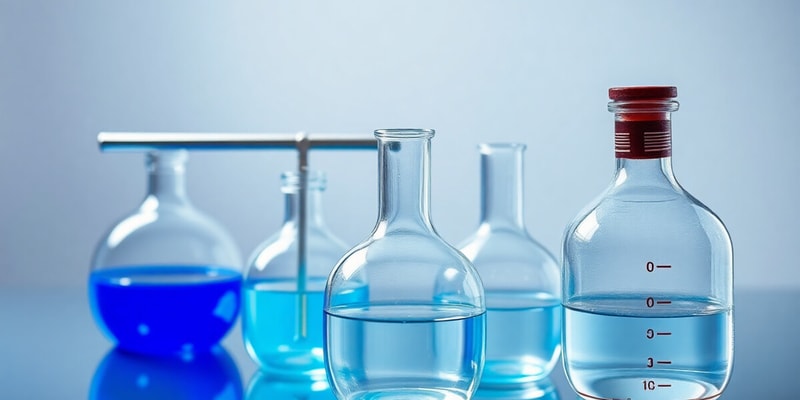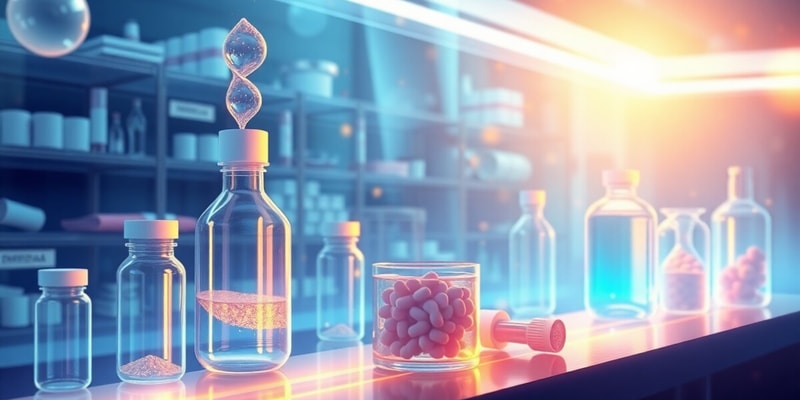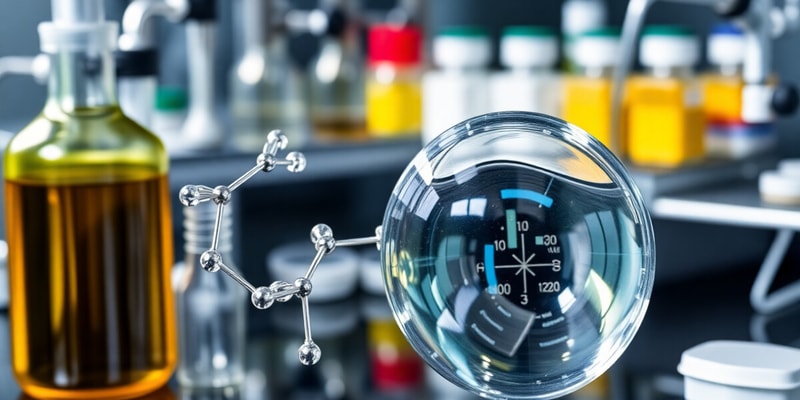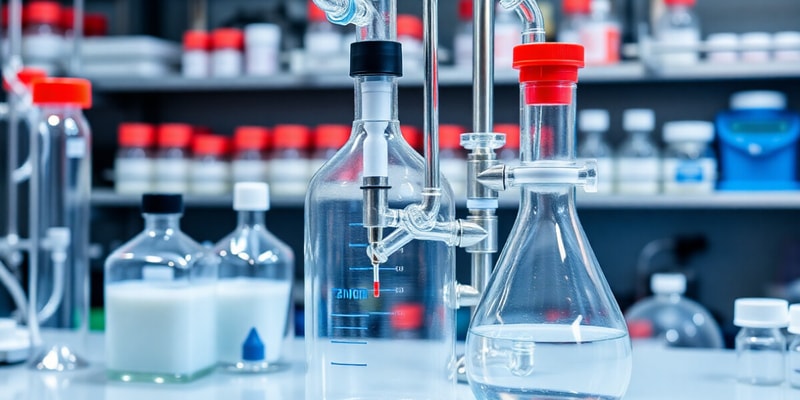Podcast
Questions and Answers
The energy of a system is the key determinant of equilibrium, structure and stability.
The energy of a system is the key determinant of equilibrium, structure and stability.
True
Ideal gases exhibit defined spatial relationships and significant chemical interactions between molecules.
Ideal gases exhibit defined spatial relationships and significant chemical interactions between molecules.
False
Boyle's law describes the relationship between pressure and volume at constant temperature for an ideal gas.
Boyle's law describes the relationship between pressure and volume at constant temperature for an ideal gas.
True
Under all conditions, all gases behave ideally.
Under all conditions, all gases behave ideally.
Signup and view all the answers
Dynamic equilibria occur only in systems that have reached stability.
Dynamic equilibria occur only in systems that have reached stability.
Signup and view all the answers
The relationship between energy of a system and the equilibrium constant K is essential for understanding chemical processes.
The relationship between energy of a system and the equilibrium constant K is essential for understanding chemical processes.
Signup and view all the answers
Complex pharmaceutical systems cannot be developed from theories based on simple systems such as ideal gases.
Complex pharmaceutical systems cannot be developed from theories based on simple systems such as ideal gases.
Signup and view all the answers
Charles’ law examines the relationship between volume and temperature of a fixed amount of an ideal gas while keeping pressure constant.
Charles’ law examines the relationship between volume and temperature of a fixed amount of an ideal gas while keeping pressure constant.
Signup and view all the answers
The change in enthalpy (ΔH) solely determines the direction of spontaneous change in a process.
The change in enthalpy (ΔH) solely determines the direction of spontaneous change in a process.
Signup and view all the answers
Entropy (S) is defined as the degree of order or organization in a system.
Entropy (S) is defined as the degree of order or organization in a system.
Signup and view all the answers
Heat flows from a colder body to a hotter body during spontaneous processes.
Heat flows from a colder body to a hotter body during spontaneous processes.
Signup and view all the answers
A process can occur spontaneously in the reverse direction without any intervention.
A process can occur spontaneously in the reverse direction without any intervention.
Signup and view all the answers
As temperature decreases, the entropy of a single component increases.
As temperature decreases, the entropy of a single component increases.
Signup and view all the answers
The internal energy of an isolated system can change over time.
The internal energy of an isolated system can change over time.
Signup and view all the answers
The work done on a system is considered positive when expanding the volume at constant pressure.
The work done on a system is considered positive when expanding the volume at constant pressure.
Signup and view all the answers
The molecular mass of oxygen (O2) is 32 g mol−1.
The molecular mass of oxygen (O2) is 32 g mol−1.
Signup and view all the answers
The formula for the First Law of Thermodynamics is ΔU = q + w.
The formula for the First Law of Thermodynamics is ΔU = q + w.
Signup and view all the answers
The pressure inside a cylinder will not leak unless the temperature exceeds 1.0 x 10^6 Pa.
The pressure inside a cylinder will not leak unless the temperature exceeds 1.0 x 10^6 Pa.
Signup and view all the answers
The mole fraction of oxygen (O2) in air is typically around 0.21.
The mole fraction of oxygen (O2) in air is typically around 0.21.
Signup and view all the answers
According to Boyle's Law, at constant temperature, the pressure is directly proportional to the volume.
According to Boyle's Law, at constant temperature, the pressure is directly proportional to the volume.
Signup and view all the answers
To convert temperature from Celsius to Kelvin, you add 273.15.
To convert temperature from Celsius to Kelvin, you add 273.15.
Signup and view all the answers
In an ideal gas, energy due to interactions between molecules is significant.
In an ideal gas, energy due to interactions between molecules is significant.
Signup and view all the answers
Avogadro’s Hypothesis states that samples of different gases at the same pressure, volume, and temperature contain the same number of molecules.
Avogadro’s Hypothesis states that samples of different gases at the same pressure, volume, and temperature contain the same number of molecules.
Signup and view all the answers
The formula PV = nRT is not valid when calculating the amount of gas in a given volume.
The formula PV = nRT is not valid when calculating the amount of gas in a given volume.
Signup and view all the answers
Charles' Law indicates that volume is proportional to temperature at constant pressure.
Charles' Law indicates that volume is proportional to temperature at constant pressure.
Signup and view all the answers
Heat absorbed by a system is quantified by a positive value of q.
Heat absorbed by a system is quantified by a positive value of q.
Signup and view all the answers
The ideal gas law equation is expressed as PV = nRT.
The ideal gas law equation is expressed as PV = nRT.
Signup and view all the answers
The mole fraction of a component in a mixture is defined as the number of moles of that component divided by the total number of moles in the mixture.
The mole fraction of a component in a mixture is defined as the number of moles of that component divided by the total number of moles in the mixture.
Signup and view all the answers
The constant R in the ideal gas law equation varies with changes in temperature.
The constant R in the ideal gas law equation varies with changes in temperature.
Signup and view all the answers
Pressure and volume of an ideal gas are related by Avogadro’s Hypothesis.
Pressure and volume of an ideal gas are related by Avogadro’s Hypothesis.
Signup and view all the answers
One mole of a pure substance contains approximately 6.022 x 10^23 entities.
One mole of a pure substance contains approximately 6.022 x 10^23 entities.
Signup and view all the answers
In a mixture of ideal gases, the total pressure is the sum of the partial pressures of each gas.
In a mixture of ideal gases, the total pressure is the sum of the partial pressures of each gas.
Signup and view all the answers
For n moles of an ideal gas, the temperature must always be expressed in degrees Celsius for calculations.
For n moles of an ideal gas, the temperature must always be expressed in degrees Celsius for calculations.
Signup and view all the answers
The value of ΔHf⁰ for fumaric acid is higher than that for maleic acid.
The value of ΔHf⁰ for fumaric acid is higher than that for maleic acid.
Signup and view all the answers
Hess's Law states that ΔH for a process depends solely on the total enthalpy change of a system.
Hess's Law states that ΔH for a process depends solely on the total enthalpy change of a system.
Signup and view all the answers
The standard enthalpy of formation ΔHf° of Cl2 (g) is equal to zero.
The standard enthalpy of formation ΔHf° of Cl2 (g) is equal to zero.
Signup and view all the answers
The reaction of glucose and oxygen includes forming glucose as a product.
The reaction of glucose and oxygen includes forming glucose as a product.
Signup and view all the answers
The calculated value of ΔHrxn for the reaction of C2H4 and Cl2 is −219.5 kJ mol−1.
The calculated value of ΔHrxn for the reaction of C2H4 and Cl2 is −219.5 kJ mol−1.
Signup and view all the answers
The value of ΔHf⁰ for CS2 (l) calculated using Hess's Law is 129.7 kJ mol−1.
The value of ΔHf⁰ for CS2 (l) calculated using Hess's Law is 129.7 kJ mol−1.
Signup and view all the answers
The ΔH for a reaction at constant pressure is generally represented as ΔHrxn.
The ΔH for a reaction at constant pressure is generally represented as ΔHrxn.
Signup and view all the answers
The enthalpy of formation for a compound is always a positive value.
The enthalpy of formation for a compound is always a positive value.
Signup and view all the answers
For the reaction of fumaric acid converting to maleic acid, ΔHrxn is calculated by taking the difference of their enthalpies of formation.
For the reaction of fumaric acid converting to maleic acid, ΔHrxn is calculated by taking the difference of their enthalpies of formation.
Signup and view all the answers
At 305 K, the enthalpy change during glucose metabolism is negligible.
At 305 K, the enthalpy change during glucose metabolism is negligible.
Signup and view all the answers
Study Notes
Structure and Stability of Pharmaceutical Systems
- Equilibrium constants and dynamic equilibria are key elements of structure and stability.
- Pharmaceutical systems are complex, but simplified systems can be used to develop theories.
Energy and Equilibrium
- The energy of a system is the key determinant of equilibrium, structure, and stability.
- Ideal gases are the simplest systems to understand.
- Ideal gases consist of molecules moving randomly with no interactions between them.
Ideal Gases
- Some gases behave close to ideal under specific conditions.
- Boyle's law relates pressure to volume at constant temperature: P ∝ 1/V.
- Charles' law relates volume to temperature at constant pressure: V ∝ T.
- The ideal gas law combines Boyle's and Charles' law: PV = nRT, where R is the gas constant.
Mixtures of Ideal Gases
- The total pressure of a mixture of ideal gases is the sum of the partial pressures of each component.
- Mole fraction is used to determine the proportion of each component in the mixture.
The First Law of Thermodynamics
- Energy cannot be created or destroyed.
- Internal energy (U) is the total energy of a system.
- For ideal gases, internal energy is due to translational, rotational, and vibrational motion.
- The internal energy of an isolated system is constant.
Changes to the Internal Energy of a System
- Changes in internal energy (ΔU) can occur through heat transfer (q) and work (w).
- ΔU = q + w
Work and Pressure-Volume Changes
- Work done on a system is positive; work done by a system is negative.
- Work done by a system expanding at constant pressure is P * ΔV.
Hess's Law and Enthalpies of Reaction
- The enthalpy change of a reaction is independent of the path taken.
- Enthalpy changes for multi-step processes can be calculated by adding the changes for each step.
The Direction of Spontaneous Change
- The first law of thermodynamics states energy is conserved.
- Entropy is a measure of disorder or randomness.
- Changes in enthalpy (ΔH) and entropy (ΔS) determine the direction of change.
Spontaneous Processes
- Many processes occur spontaneously in one direction, like heat flowing from hot to cold.
- Entropy increases for spontaneous processes.
- Reverse processes require work or intervention.
Studying That Suits You
Use AI to generate personalized quizzes and flashcards to suit your learning preferences.
Related Documents
Description
Explore the fascinating concepts of structure, stability, and equilibrium in pharmaceutical systems. This quiz also covers ideal gas laws, including Boyle's and Charles' laws, to help you understand the behavior of gases in various conditions.




